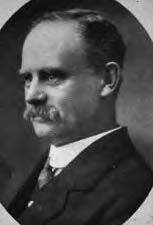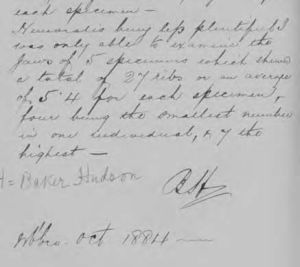|
About 12 years ago I obtained a copy of John Edward Gray’s 1857 edition of William Turton’s “Manual of the Land and Freshwater Shells of the British Islands”. The book is a ”working copy”, the binding is loose and some pages are taped, but it also has many notes in the margin and a couple of pages of handwritten interfoliations, one of which is signed “B.H. Mb’bro. Oct 1884”. A later hand has made a note in pencil “BH = Baker Hudson”. I was intrigued by this, not the least reason being that I always like to try to imagine the people who have owned a book before me. Coins pass through perhaps thousands of hands during their time in circulation, books usually have far fewer owners and those that are well used and written in, although they have little interest for collectors, hold a certain fascination. For a few years I put aside the thought of investigating further the author of the handwritten pages as other priorities took over, but more recently I have been able to find out more. Baker Hudson was born in Newcastle in 1854. His wife’s name was Edith (she was apparently a descendant of Captain James Cook) and they were married at the old Middlesbrough Roman Catholic Cathedral. As a young man he is described in the census records as a “Post Office Clerk” (this was in 1871 when he was living with his mother, aunt and great aunt in Elvet, Durham) and then “Commercial Clerk”(1881), but his obituary in the Sept 1st 1925 edition of The Naturalist states that he was appointed Librarian at Middlesborough “36 years ago” (i.e. c.1889) and the 1891 census confirms this. This corroborates the “Mb’bro…1884” after the initials in my book. Baker Hudson was a member of the Cleveland Literary and Philosophical Society Field Club. This club donated objects and specimens in the late 1860’s to create a museum at their premises on Corporation Road. In 1890 the collection was given over to the Free Library Committee, of which Baker Hudson is likely to have been an active member. Following expansion and additional donations a purpose built building became necessary and this was eventually presented to the town by Sir Arthur Dorman and opened in 1904 as the Dorman Museum. Upon the foundation of the museum, Baker Hudson was appointed as its first curator until his resignation 19 years later at the age of 69. He was particularly interested in conchology and notes on that subject appeared in The Naturalist, but from 1883 to 1887 he also contributed notes on the Land and freshwater Shells of Middlesborough to Science Gossip and perhaps more importantly a small number of communications on non-marine molluscs were published in The Journal of Conchology (see list). Dorman Museum confirmed that the handwriting in the book matched their samples of Baker Hudson’s script in their collection. The date of the notes in the book coincide with the period of Baker Hudson’s conchological publications and I have not been able discover any more publications after the time he was appointed to the senior librarian post. This appears to indicate that after this period he may have had less time to devote to his interest, however Hudson becoming secretary of the conchological section of the Yorkshire Naturalists’ Union in 1888 indicating continued activity in this area. In the front of my copy of “Gray’s Turton” another hand has written “an old book from an old friend, Christmas 1902”, so it is obvious that Baker Hudson no longer owned the book at this time. It is clear from the subject of many of the notes that Baker Hudson was interested, like many other Victorian conchologists, in the possibility of new subspecies and forms of common nonmarine snails. For instance, in the margin of the description of the pond snail “Limnaeus pereger” (now Radix balthica L., 1758) Baker Hudson has listed his knowledge of no less than 16 named “varieties” of this species, and he has repeated this for many other species described in the book. However the majority of his comments concern the banded snails “Helix” (now Cepaea) hortensis and nemoralis. For instance he refutes Gray’s quotation from Sheppard indicating the possibility that the curvature of the love dart of C. nemoralis is related to the number of bands on the shell, saying that his own observations agree with those of other authors (he quotes here Ashford, J. Conch 4:164 and Schmidt) that this is definitely not the case and any variation is probably artifactual. He was also interested in whether brown-lipped hortensis were really a result of hybridization between the two species. Gray and other authors even called such specimens by the specific name “Helix hybrida Poiret”. Baker writes, “My own observations herein have not been very extended, all the specimens examined being taken at Durham. The shells were of the size of hortensis with which species and nemoralis they were associated, the latter species being far from abundant – Their colouration was a uniform rich purple with tinges of yellowish brown and the lips of a pinkish to purple tint. The size of the shells varied from 21 to 25 thirty-seconds of an inch in diameter & from 13 to 17 thirty-seconds of an inch in height. An examination of the jaws showed the following result: 10 specimens; 4 had 3 ribs each and 6 had 4 ribs each giving a total number of ribs in the 10 of 36 or an average of 3.6 to each specimen. The darts showed the specimens to be a var. of hortensis. Only two specimens were noted as to the mucous glands. They showed the total number of branches to be 7. The jaws of 37 specimens of hortensis were examined & the total no. of ribs was [? unreadable] giving an average of 3.5 for each specimen. Nemoralis being less plentiful I was only able to examine the jaws of 5 specimens which showed a total of 27 ribs or an average of 5.4 for each specimen, four being the smallest number in one individual and 7 the highest.” Nowadays the characteristics of the darts and the number of branches to the mucous gland are still recognized as important characters to separate the species, but although rare hybrid characters are sometimes observed a hybrid “species” has not been recognized in modern literature and the importance for identification of variation within populations and type of habitat is also recognized. Nevertheless it is clear that Baker Hudson was carrying out his own research in a small way in the 1880’s and coming to his own logical conclusions whilst confirming the published findings of others working at that time. Baker Hudson’s publications in the Journal of Conchology:- 1885. Occurrence of Hartmannia septemspiralis (Razoumousky) and H. patula (Drap.) in England. 4: 353-355. 1886 Notes on the land and freshwater mollusca of the lower Tees. 5: 46-48. 1887 Description of a new variety of Planorbis carinatus Mull. 5: 249. 1887. Hogg’s list of the mollusca of the neighbourhood of Stockton-on Tees. 5: 256-260 References Cameron, R. 2003. Land Snails in the British Isles. Field Studies Council. Turton W. 1857. Manual of the Land and Fresh-Water Shells of the British Islands, new edition by J.E.Gray, London. Acknowledgements
I would like to thank Ian Stubbs, assistant curator of the Dorman Museum, Middlesbrough, for providing the photograph of Baker Hudson, confirming the handwriting as his and for further biographical details. Thanks are also due to Peter Dance and Adrian Norris for pointing me in the right direction and providing much useful information. |
Fig 1 Baker Hudson
Fig 2 |
Baker Hudson and some notes on Cepaea
Issue
11
Page
8


